Situated in a suburb of Manchester, England this is a story of a co-op store still with meeting rooms above the shop, and the lane itself. Plus other related or not so related history.
Sunday, October 27, 2013
Co-Op First Self Service UK
If you browse for finding the first self service store in Britain then you'd have to dig very deep to find any mention of a co-operative bringing the concept from the USA to the UK. There was a recent three part documentary on shopping and retailing by the BBC and any part that the CWS or any co-operative society played in any retail innovation was seriously omitted.
The first own label goods are by the CWS date from 1873 and the use of own manufactured goods to beat the restrictions of Retail Price Maintenance are from 1906 with some patent medicines, and better known the Defiant Radios in 1933.
Now to the first self service grocery, it wasn't J.Sainsbury or Tesco but the London Co-Op Society who opened a small section in a Romford department store in 1942. Apparently introduced to alleviate staff shortages during the war. The first stand alone self service shop in Britain goes to Portsea Island Co-Op in March 1948. It's one of those great trivia facts that the city of Portsmouth is actually on an island linked by bridges to the English peninsular. Portsea island being the third most populated island the British Isles.
The London Co-Op Society sent a delegation to the USA and Canada as early as 1938 to study the self service format. The CWS sent a research team to the USA in 1947, and published guidance on how to run a self service outlet in 1949. The M&SE (Manchester & Salford Equitable) took to idea and started altering its existing stores the following year. Eventually the format came to the smaller stores like Hardy Lane in 1959.
[ Information from the letter pages of the Co-Operative News in October 2013 ]
Thursday, October 3, 2013
CWS 150 renamed and not out
Not many companies can make 150 years of trading but the Co-Operative Group was founded as the North of England Co-operative Wholesale Industrial and Provident Society Limited in Manchester in 1863. From 1872 it became the Co-Operative Wholesale Society (CWS), and after a merger with Co-Operative Retail Services in 2000 they chose the name Co-Operative Group.
Forward to the present day and an exhibition at the People's History Museum in Manchester on Saturday 12th October 2013 thru to Saturday 11th May 2014. Plenty of visiting days, it's free and there is a fine cafe too. More to follow....after the exhibition opens. Might as well join in by publishing some photos of CWS memorabilia like the 1940's packet of tea as seen above. That's a 4oz packet of loose tea before tea bags became the norm...more pictures to follow.
All the links you need:
The People’s Business – 150 Years of The Co-operative
Co-Op Events at the People's History Museum
Co-Operative Group at 150 years (pictures and timeline)
Forward to the present day and an exhibition at the People's History Museum in Manchester on Saturday 12th October 2013 thru to Saturday 11th May 2014. Plenty of visiting days, it's free and there is a fine cafe too. More to follow....after the exhibition opens. Might as well join in by publishing some photos of CWS memorabilia like the 1940's packet of tea as seen above. That's a 4oz packet of loose tea before tea bags became the norm...more pictures to follow.
All the links you need:
The People’s Business – 150 Years of The Co-operative
Co-Op Events at the People's History Museum
Co-Operative Group at 150 years (pictures and timeline)
Tuesday, September 17, 2013
Touching History Roby Church
I've written many times about how the Manchester & Salford Equitable Co-op was founded by members of the Roby Brotherhood. A 19th Century group of young men who worshipped at the Roby Church and had attended that Sunday School. Walking down Dickenson Road you can see one of their former church buildings. It's at the corner of Hamilton Road and is now used by the Church of God of Prophesy. Better still sautering further south down Dickenson Road is the actual successor church, the Roby United Reform Church. A neat stylish building in smart brick with a small attractive garden. There you can touch the names carved in stone of the early preachers.

William Roby was invited to preach at the Cannon Street chapel in 1830, and they moved to larger premises on Grosvenor Street in 1807. The chapel was renamed Roby in his memory after his death. I doubt if many of the founders of the Manchester & Salford Co-op would have heard him speak. But they would have been familiar with Richard Fletcher who went off to pastures new in Melbourne, Victoria, and Patrick Thomson who had a long career at various independent churches.
As a side note to illustrate how history is an ivy that intertwines. William Roby (1766-1830) ran an academy to teach independent preachers, and from 1803-1808 it was funded by Robert Spear (1792-1819) a wealthy cotton merchant in Manchester. "Robert Owen describes how Spear sent him the first two bags of Sea Island cotton to land in Britain. It was through Spear's sister that Owen met his future wife Caroline Dale." - paraphrased from the Life of Robert Owen (1920). The New Lanark mills were part of the marriage settlement. Yet another co-op connection.
Further Reading :
William Roby brief biog
History of the Roby Church

William Roby was invited to preach at the Cannon Street chapel in 1830, and they moved to larger premises on Grosvenor Street in 1807. The chapel was renamed Roby in his memory after his death. I doubt if many of the founders of the Manchester & Salford Co-op would have heard him speak. But they would have been familiar with Richard Fletcher who went off to pastures new in Melbourne, Victoria, and Patrick Thomson who had a long career at various independent churches.
As a side note to illustrate how history is an ivy that intertwines. William Roby (1766-1830) ran an academy to teach independent preachers, and from 1803-1808 it was funded by Robert Spear (1792-1819) a wealthy cotton merchant in Manchester. "Robert Owen describes how Spear sent him the first two bags of Sea Island cotton to land in Britain. It was through Spear's sister that Owen met his future wife Caroline Dale." - paraphrased from the Life of Robert Owen (1920). The New Lanark mills were part of the marriage settlement. Yet another co-op connection.
Further Reading :
William Roby brief biog
History of the Roby Church
Sunday, September 15, 2013
Longsight Printing Works
Reading through many old co-op society magazines and pamphlets the imprint "CWS Printing Works Longsight" is on the publication. I thought the old printing works had long since been demolished until I took a cycle short cut down Hamiliton Road in Longsight and caught glimpse of the building. It took a few more months before returning with a camera.
CWS Printing commenced in January 1895 off Balloon Street in Manchester, and such was the need for more output a site was acquired in Longsight and production commenced in July 1898. The works expanded over the years and employed 1,100 persons in 1913. Printing wasn't as mechanised as today so lots of hands, both men and women were needed to collate, trim, bind and box all that paper.

The attractive engraving shows a magnificent structure and with artistic licence the roads are shewn overly wide and spacious. Built on large open plot behind the shops on Stockport Road with Gore Brook and Rushford Farm to the right and east of this illustration. It has been knocked about since its heyday. The chimney and pond have gone, the brook is under a culvert but the original entrance to the offices on Hamilton Road survives.

 The illustration is from The Story of the CWS: the jubilee history of the Co-Operative Wholesale Society by Percy Redfern (1913). You can download it at Archive.Org
The illustration is from The Story of the CWS: the jubilee history of the Co-Operative Wholesale Society by Percy Redfern (1913). You can download it at Archive.Org
CWS Printing commenced in January 1895 off Balloon Street in Manchester, and such was the need for more output a site was acquired in Longsight and production commenced in July 1898. The works expanded over the years and employed 1,100 persons in 1913. Printing wasn't as mechanised as today so lots of hands, both men and women were needed to collate, trim, bind and box all that paper.

The attractive engraving shows a magnificent structure and with artistic licence the roads are shewn overly wide and spacious. Built on large open plot behind the shops on Stockport Road with Gore Brook and Rushford Farm to the right and east of this illustration. It has been knocked about since its heyday. The chimney and pond have gone, the brook is under a culvert but the original entrance to the offices on Hamilton Road survives.

 The illustration is from The Story of the CWS: the jubilee history of the Co-Operative Wholesale Society by Percy Redfern (1913). You can download it at Archive.Org
The illustration is from The Story of the CWS: the jubilee history of the Co-Operative Wholesale Society by Percy Redfern (1913). You can download it at Archive.Org
Monday, April 29, 2013
Northmoor Road
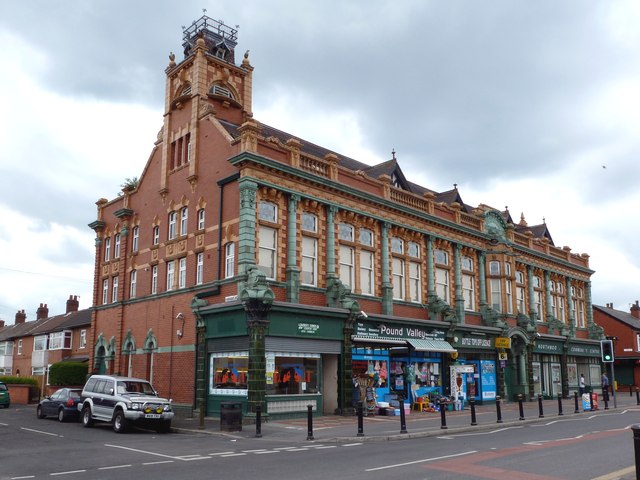
The old co-op building on Northmoor Road in Longsight, Manchester M12 5RT is an impressive building. Enough to be classed as a Grade II Listed Building in 1994. The other week it celebrated its centenary, only a few months late as the date on the building states 1912.
It was built for the Beswick Co-operative Society, founded in 1892, and a thorn in the trading area of the Manchester & Salford Equitable. The Beswick ignored any territorial agreements and would open branches were they felt they could do business. Thus districts like Levenshulme, Ancoats, Withington and Didsbury would have rival co-op stores.
Northmoor Road, originally called North Road was developed between 1899 thru to the 1930's. The most famous person to reside there was J.R.Tolkien between 1926-1947. We don't know if he went to the co-op for his tea and biscuits between writing another page of The Hobbit or Lord of The Rings.
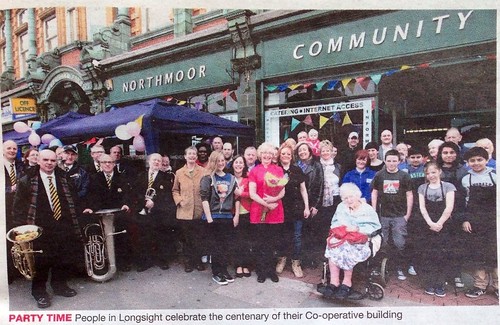
The building rises up to two floors plus attic rooms in a square tower. It used to have a meeting room used as ballroom for dances to live music. The property is now owned by Great Places Housing Group who provide affordable, social and supported housing across the north west and Yorkshire. There is now a community centre and small business units on the ground flour. Apartments are on the upper levels. It's not every building that has a party by local residents to celebrate its 100th birthday. It was reported in the local newspaper, "the co-operative building is loved by all in the area, and that showed with the amount of local residents who came to the event." - South Manchester Reporter 25th April 2013.
There is no doubt a lot of history to this building, it is something I must follow up someday.
Further reading : Northmoor Road (Wikipedia)
Description of the architectural features (Images of England)
Photo credit to www.geograph.org.uk
Sunday, April 7, 2013
Trams beyond Chorlton

The tram tracks are now being laid down the centre of Hardy Lane. Slowly the construction of the line to connect the airport with the centre of Manchester is coming along. I'm recording the progress with photographs.
As Hardy Lane is not a busy thoroughfare for cars reducing the road to single line traffic shouldn't cause any long tail backs. However the siting of the station at the junction of Mauldeth Road West and Barlow Moor Road might isn't ideal. Not ideal for foot passengers who will have to cross two main roads to reach the platforms. You have a similar situation in Droylsden and there are no cycle lanes to contend with there.
The picture below is from the Manchester Libraries Archives. It shews the tram times to reach the centre of town from the outlying districts in 1917.
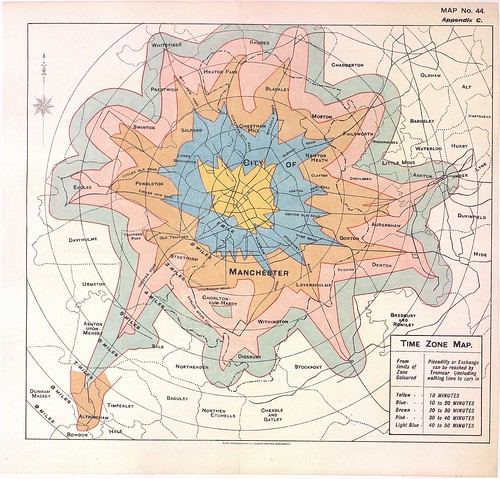
Depending on which part of Chorlton-cum-Hardy you lived in it could take from between 20 minutes to 50 minutes to arrive at Piccadilly. It is maybe marginally faster on the Metrolink these days but then you have to factor in the time to walk to the station.
Friday, March 29, 2013
Twin tubs carry on

I'll draw your attention to a famous brand of washing powder and the words printed on the packet. The reference is to "twin tubs". Had I stepped into the past and not another shopping trip to the local Co-Op. Well apparently twin tub washing machines are still manufactured and presumably someone is buying them and Proctor & Gamble are marketing a washing powder to cater for that market. It is not widely promoted in the Daz range, it hardly gets a mention. What's the difference? This soap powder will make more suds so is unsuitable for an automatic washing machine.
Washing clothes that weekly chore that requires lots of hot water isn't the full drudge day of years ago. Well not when you have an automatic washing machine. So there must be some reasons why people still favour the machine of choice from the 1960's. Maybe it does a cleaner wash, or is eco-friendly besides being a cheaper capital purchase. The powder is also for handwash (not hand wash) and you can't go further back in history than laundry by hands.
Wednesday, March 27, 2013
Gramophone Music
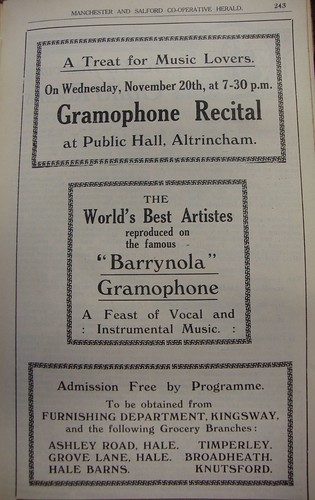
The history of recorded music is how it has progressively become cheaper and more convenient. You don't even have to possess the physical object that holds the sound just some electronic device that can play it. Literally bushels of songs at the fingertip. The advert is from the 1930's and the M&SE are stocking the new Barrynola gramophone. Note it is being demonstrated at a concert in one of the more salubrious suburbs of Manchester. A night out listening to records - no mention if dancing was allowed.
Interesting class dimension in that the Co-Op was appealing to not just the weekly struggle working class customer but to customers who had regular income with savings.
They were an expensive purchase not one for a struggling working family. A small portable would cost just under £3 (3 GBP), a cabinet model from £7 to £10. Then there were the new electric models using mains electricity. The new radiograms were also coming on the market, a status piece of furniture that would be desired for living rooms for the next twenty years. This was an age of developments in reproducing sound. Just as today there is that newer and better model available after you've paid your hard earned cash and taken delivery. Last year I purchased an iPod Nano that also doubles as a wrist watch. That model has been superseded, and my Zen MP3 player is ancient. We've not even gone into the junk room to find museum pieces like the Walkman.
The co-op society did hire gramophones and the Womens' and Mixed Guilds made use of such facilities to have a meeting based around listening to recorded music. I had an earlier post, it was back in 2009, about 78 rpm records that were played at Hardy Lane. It is here.
So there you have it. I'm sat on the tram listening to my own personal playlist on little ear speakers and all those years ago it was a treat of an evening in a hall hearing gramophone records.
Saturday, March 23, 2013
Defiant Radio Story #1
The Rochdale Pioneers Museum is having a 'Defiant Radios Fun Day'.
That's Wednesday April 10th 2013 from 1100 - 1600h. A heady cocktail of
vintage radio and co-operative history. Steady.
The Defiant radio story is one of co-operatives set against price fixing by a cartel of electrical manufacturers. At the time the Co-op wanted to sell radio sets but they could not "discount" and the "divi" was a form of discount. So the solution was to find a subcontractor to make their own brand. Eventually a deal was struck with Plessey to make the radios, with Mazda valves the brand name of BTH (British Thompson-Houston, I think it was a subsidiary of AEI then) and the wooden cases to enclose the receiver were supplied by the CWS cabinet works. It's appropriate that they called their own brand of radio "Defiant".
The Resale Prices Act abolished price fixing in 1964. After that the retailer or chain store could decide their own price for goods . Ironically the end of retail price maintenance in Britain had a devastating affect on co-operative society sales especially food, and helped the rise of the multiples .
The Defiant wireless sets were on sale from 1933 with the MSH 901 manufactured by GEC but they joined the Radio Manufacturers Association embargo of dealing with the CWS hence a 1934 deal with Plessey. Later radiograms, gramophones, record players, transistor radios and a television in the 1950's were available. At least 85 different models were put on sale until 1967. All now collectors' items but affordable that is if you can obtain a working model. Why haven't I bought one?
Back in the 1930's a wireless would set you back two weeks average wages of work, there weren't many radio stations to tune into and you had to pay the annual licence fee of ten shillings (50p). But still a must have big ticket item of its day bringing music and talk into your home that we take for granted.
Pictures : Dial of the Defiant MSH902 from 1934; Defiant MSH914 from 1935-1938,
Link :Rochdale Pioneers Museum Defiant Radio Day
Links for more
The Defiant radio story is one of co-operatives set against price fixing by a cartel of electrical manufacturers. At the time the Co-op wanted to sell radio sets but they could not "discount" and the "divi" was a form of discount. So the solution was to find a subcontractor to make their own brand. Eventually a deal was struck with Plessey to make the radios, with Mazda valves the brand name of BTH (British Thompson-Houston, I think it was a subsidiary of AEI then) and the wooden cases to enclose the receiver were supplied by the CWS cabinet works. It's appropriate that they called their own brand of radio "Defiant".
The Resale Prices Act abolished price fixing in 1964. After that the retailer or chain store could decide their own price for goods . Ironically the end of retail price maintenance in Britain had a devastating affect on co-operative society sales especially food, and helped the rise of the multiples .
The Defiant wireless sets were on sale from 1933 with the MSH 901 manufactured by GEC but they joined the Radio Manufacturers Association embargo of dealing with the CWS hence a 1934 deal with Plessey. Later radiograms, gramophones, record players, transistor radios and a television in the 1950's were available. At least 85 different models were put on sale until 1967. All now collectors' items but affordable that is if you can obtain a working model. Why haven't I bought one?
Back in the 1930's a wireless would set you back two weeks average wages of work, there weren't many radio stations to tune into and you had to pay the annual licence fee of ten shillings (50p). But still a must have big ticket item of its day bringing music and talk into your home that we take for granted.
Pictures : Dial of the Defiant MSH902 from 1934; Defiant MSH914 from 1935-1938,
Link :Rochdale Pioneers Museum Defiant Radio Day
Links for more
Wednesday, March 20, 2013
New Co-Op Book in September 2013
The first major business history of the CWS/The Co-operative Group in over fifty years is coming out in hardback this autumn. The pre-ordering is taking place and the blurb describes what you get for thirty pounds. Yes it has pictures in it.
"Based on extensive archival research, many of the materials being made available to historians for the first time. Brings new attention to co-operatives as a distinctive business type from investor owned models. Published to coincide with the 150th anniversary of the Co-operative"
Profit with Principles? A Business History of The Co-operative Group, 1863-2013 by John F. Wilson, Anthony Webster, and Rachael Vorberg-Rugh; 464 pages | Numerous black and white illustrations; colour plate sections | 246x171mm 978-0-19-965511-3 | Hardback | September 2013 (estimated) Price: 30.00 GDP Oxford University Press
So something to look forward to then......
"Based on extensive archival research, many of the materials being made available to historians for the first time. Brings new attention to co-operatives as a distinctive business type from investor owned models. Published to coincide with the 150th anniversary of the Co-operative"
Profit with Principles? A Business History of The Co-operative Group, 1863-2013 by John F. Wilson, Anthony Webster, and Rachael Vorberg-Rugh; 464 pages | Numerous black and white illustrations; colour plate sections | 246x171mm 978-0-19-965511-3 | Hardback | September 2013 (estimated) Price: 30.00 GDP Oxford University Press
So something to look forward to then......
Tuesday, March 19, 2013
Co-Op Fashion
Was very taken with this old advert for the latest spring fashions for 1939. Surprisingly it is in colour rather than the black & white line drawings I've usually discovered. It deserves a reprise.
So what does the advertisement say. It speaks aspirational, you could be in a P.G.Wodehouse novel with your pipe, matching handkerchief in the top pocket and a modern camera. Personally I wouldn't be my choice of a check jacket going with baggy stripped trousers. I'm no fashion expert but that looks like a windowpane check which you don't see much of these days clashing with a chalk stripe trousers. The lady looks jolly sporty as well. Stood next to the daffodils for the spring connection in a dashing hat and a lovely coat again in a check. It has an interesting four button arrangement.
 No doubt if you could afford a new spring outfit you'd have looked pretty spiffy in this. There is a whole area to explore in suits, class and downright snobbery but I will leave that to others.
No doubt if you could afford a new spring outfit you'd have looked pretty spiffy in this. There is a whole area to explore in suits, class and downright snobbery but I will leave that to others.So did people go down to the shops or the local co-op store in outfits like this? Err..maybe or maybe not? It's just that photographs from this period of people going about their everyday chores look pretty dreary.
However the photo on the left is historian and curator Lucy Worsley dressed up like 1934. If you've seen any of her BBC Tv programmes you'll know she likes getting into character by wearing outfits relating to the age she's presenting. So there is possibly one from the 1930's coming on schedule as this was published this month.
Recommended viewing and better check Lucy Worsley on the web. Enjoyable history not just entertainment but you get facts even a jaded viewer will find riveting.
The next picture is a section of a poster from around 1935 by F.C. Harrison (that's Frederick Clifford, painter and illustrator 1901 - 1984).
He worked freelance, and this is one for the Empire Marketing Board currently on display at Manchester Art Gallery. The lady has bought a pineapple which was a luxury. So back from the shops on a winter's day dressed in a very long scarf, large possibly fleece lined gloves, and the snug hat. Not very colour co-ordinated but maybe that's the illustrator trying to attract our attention.
Further reading : Empire Marketing Board posters on Flickr thanks to Manchester City Galleries.
Thursday, March 14, 2013
M&SE Head Office

The photograph is from 1963 and shews the Manchester & Salford Equitable Co-op head office and central stores. The building was then 100 years old and is looking a little worse for wear. The addition of a rendering over the brickwork and stone lintels of the upper storeys is no longer giving it a modern appearance. There used to be a tower above the doorway in the centre of the building and spires at the front corners. Not sure when these were demolished but before the 1950's.
This was the era of slum clearances and Ardwick or is it Chorlton-on-Medlock were the building was situated was part of that inner city renewal. We've had a few more since then and the area never recovered its population or any vibrancy. There is already a vacant lot across the road and thus the photographer can obtain a good long shot.
Photograph courtesy of Manchester Libraries Image Collection, number m19204. Click the picture for a more detailed view. To see how the building looked in 1909 still in its Victorian splendour see an earlier post here.
Friday, March 8, 2013
Saving Stamps
The Co-operative Food reports sales of saving stamps on the increase. I was drawn to the story published in Talking Retail - the hub for grocery retail of 6th March 2013. Like most of print & web media they publish press releases and this one is by the Co-operative Group.
"The Co-operative Food says sales of saving stamps have soared by a third, following the launch of its new saving stamps trust fund. The retailer said that in the first four weeks following the trust fund launch, the number of saving stamps sold increased by 33%, compared with February 2012."
Basically you buy £1 stamps throughout the year at any of its 2,800 stores across the UK. Saving is a laudable activity and should be encouraged. Far less costly than the misery of debt. Anyone redeeming a full saving stamps book (with £48 worth of stamps) in store in December will receive an extra £2 bonus, just in time for the big Christmas shop. Which if my arithmetic is correct is a return of 4.1%. Far better than the banks on the high street. Except the pay out is in goods not cash.
Something as simple as saving stamps reminds me of an age maybe 50 plus years ago. But then lots of recent developments in finance outside the tarnished banking sector are redolent of an earlier age. There are now more pawnbrokers, gold buyers, and pay-day loan merchants who charge 4000%. Then there are better and more realistic, newer peer-to-peer lending schemes and the stable credit unions. I expect to see a sign in some shop announcing "join our xmas club today".
Further reading : Saving Nostalgia by Paul Delplanque for the Gazette in Middlesboro. It is a humorous piece with some good photos of divi day and Princess Anne on one shilling national saving stamps (5p was once a lot of money).
Wednesday, February 27, 2013
Fairtrade at Co-op
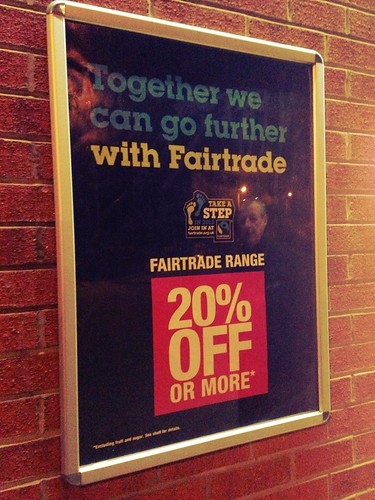
It's Fairtrade Fortnight and for another year "The Co-operative" shews its support with 20 per cent off everything that is officially fairly traded. Like the way the co-op has stuck to selling fairtrade, it must be 19 long years now. Whilst the capitalist supermarket chains have blown hot, token gesture, and indifferent over the years, a band wagon to be hitched or ditched in pursuit of sales the co-operatives have added more and more lines.
This year they've added roses for those who take cut flowers home and mung bean sprouts for those who like to do a bit of wok cookery in the kitchen.
A point I've made many times in the past is the difficulty in making the engagement in shopping with the economic and political message. Who is aware of The Co-op Bank and the anti-shale gas campaign? Co-op stores struggle with this engagement. But so does every retail outlet.
It's the art in the bar experience. The owners want you to look at the nice pictures by a local artist they've tacked on the walls. You want a coffee and cake. Some might notice the pictures which makes everyone happy. Job done and success if you ignore the majority who were never aware of their surroundings. Anyway, was hoping to find the 99 Tea Gold, it's a stronger fairtrade brew, but Hardy Lane doesn't stock it. Ah well, you can't always get you want. Settle for a few bottles of the Malbec the fruity wine number from Argentina. It's fairtrade.
Tuesday, February 19, 2013
Pioneers Display
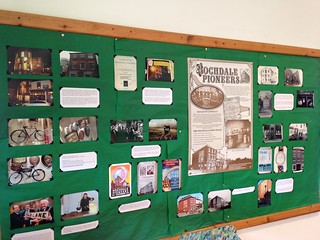 To promote the newly refurbished
Rochdale Pioneers Museum there is a display of photographs with text at the Unicorn Co-Operative Grocery store in Chorlton.
To promote the newly refurbished
Rochdale Pioneers Museum there is a display of photographs with text at the Unicorn Co-Operative Grocery store in Chorlton.It captures scenes from Toad Lane through the ages. The Pioneers only traded from this store for 23 years but it has become the shrine to the birthplace of co-operation.
You can probably give credit to George Jacob Holyoake for immortalising the Pioneers struggle and achievements with a book in 1857.
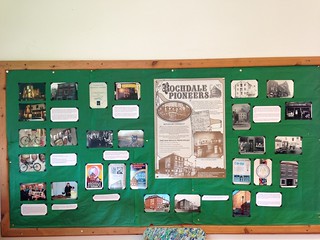 Fortunately the Co-operative Union had the foresight back around 1925 to buy the property when it was a pet shop and turn it into a museum.
Fortunately the Co-operative Union had the foresight back around 1925 to buy the property when it was a pet shop and turn it into a museum.Since then the story has been the subject of two films, in 1944 and 2012, several books and hundreds of magazine and newspaper articles.
Anyway it is a good display and many of the photographs will be new to a lot of people. A good example of co-operation between co-operatives.
Thursday, February 14, 2013
Co-Op Check Tin
So you stumble over some item for sale, puzzled by the object and curiosity wants answers. Said item is a co-operative check tin possibly from the 1920's. It's not made by a co-operative but is made for co-operative shoppers to keep little slips of paper safe. On paying for their purchases customers were given a small paper receipt with the amount spent and their membership number.
I suppose some would keep these safe and calculate if their dividend on purchases had been tallied correctly. I suspect not many could be that bothered and accepted the dividend listed by the co-op head office.
Nostalgic history forums always quote people who can still remember their divi number of the family. It was ingrained into memory at an early age, for ever, and is recited for life.
 Metal boxes were given away to promote a company's products. Who doesn't like a bright useful tin to keep safe items and make homes tidy. This one came compliments of Hargreaves Brothers & Co. and maybe dates from the 1920's. It's four sides announced that you must remember to buy the following :- Linoleo Floor Polish, Gipsy Black Lead, Ocean Blue in squares & Bags, and Glosso Metal Polish. An age of coal powered grime and relentless cleaning. Note those brand names they end in the letter "O". As in Brasso, Silvo, Zeppo and so on.
Metal boxes were given away to promote a company's products. Who doesn't like a bright useful tin to keep safe items and make homes tidy. This one came compliments of Hargreaves Brothers & Co. and maybe dates from the 1920's. It's four sides announced that you must remember to buy the following :- Linoleo Floor Polish, Gipsy Black Lead, Ocean Blue in squares & Bags, and Glosso Metal Polish. An age of coal powered grime and relentless cleaning. Note those brand names they end in the letter "O". As in Brasso, Silvo, Zeppo and so on.
Hargreaves Brothers and Co started as makers of black lead and metal polish in Gipsyville which is in Hull way back in 1868. When this tin was issued the company may have been taken over by Reckitts & Son in 1922. An even older Hull company, founded in 1840 that also made starch and cleaning products.
Whether any of these products were sold alongside the CWS own brand, can't say. You get the impression from co-op histories that only CWS goods were sold but that wasn't the case. Leading brands and own brands did stack side by side in the stores. It's that co-operative magazines and advertising promoted CWS products. Very likely Glosso was available at your local co-op.
Wednesday, January 23, 2013
M&S Archive
I've done previous posts on Marks & Spencer. The link is tenuous and is based on the premise M&S used to refer to Manchester & Salford and the co-operative society of that name that built the Hardy Lane shop and rooms. There used to many organisations with Manchester & Salford in their title - e.g. Manchester & Salford Trustee Savings Bank. But the city names have fallen out of favour and the term Greater Manchester has become more widely used.
But if you are interested in the history of shopping, retail and food then the Marks & Spencer archive will be of interest. Based in Leeds where trading started on a market stall in 1884. There are pictures, a timeline and themes to explore online. I visited the exhibition when it opened a few years back. It had a cafe serving Marks & Spencer teas and snacks as well. It is a short way out of town in the university district. A day trip to Leeds is well worth a visit. Some good architecture, marvellous Victorian shopping arcades and plenty of places to obtain a decent meal.
Marks & Spencer Archive
Other posts about M&S
http://marksintime.marksandspencer.com/
But if you are interested in the history of shopping, retail and food then the Marks & Spencer archive will be of interest. Based in Leeds where trading started on a market stall in 1884. There are pictures, a timeline and themes to explore online. I visited the exhibition when it opened a few years back. It had a cafe serving Marks & Spencer teas and snacks as well. It is a short way out of town in the university district. A day trip to Leeds is well worth a visit. Some good architecture, marvellous Victorian shopping arcades and plenty of places to obtain a decent meal.
Marks & Spencer Archive
Other posts about M&S
http://marksintime.marksandspencer.com/
Monday, January 21, 2013
No longer a wide road

The end of an era for Hardy Lane, a big wide road to nowhere is now reduced to single line traffic running east and west. Mark the date as Sunday 6th January when the first barriers were installed. Now inside those barriers the road is being hacked away for the foundations of the new tram track. If the progress is anything like the development of the tramway extensions in the other parts of Manchester then expect the barriers to be still there in twelve months time.
Subscribe to:
Posts (Atom)
You can email : coop AT biffadigital.org with any information that will help in the making of this history.









